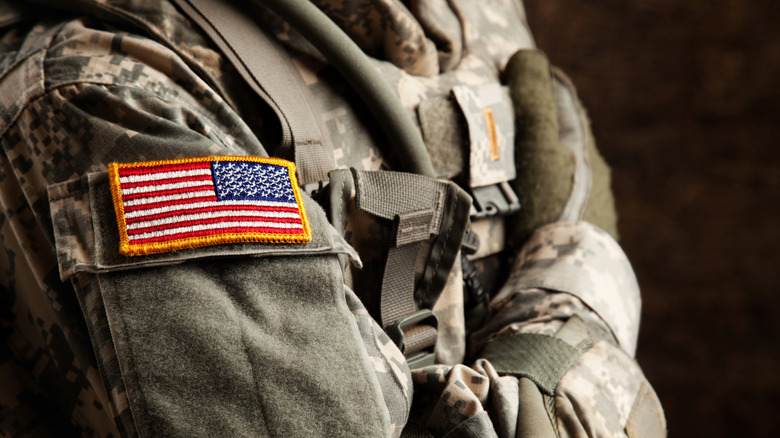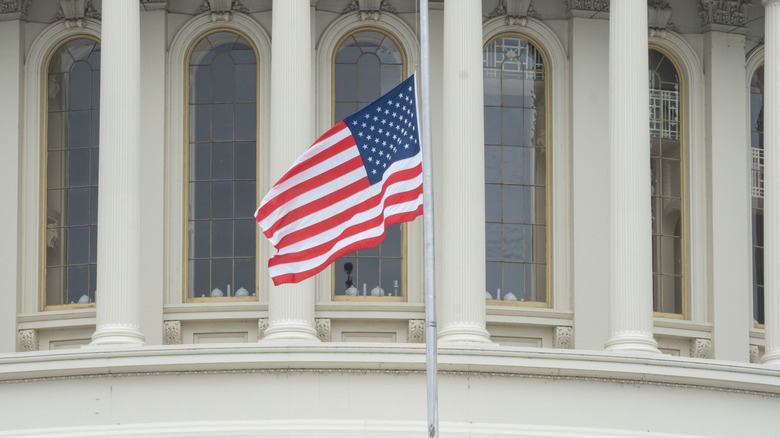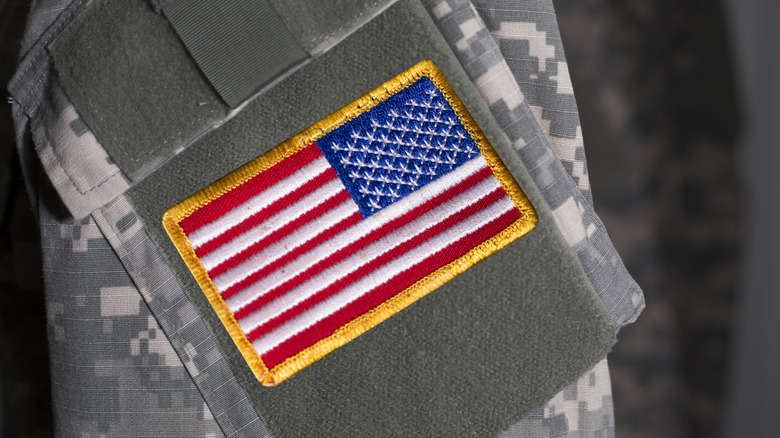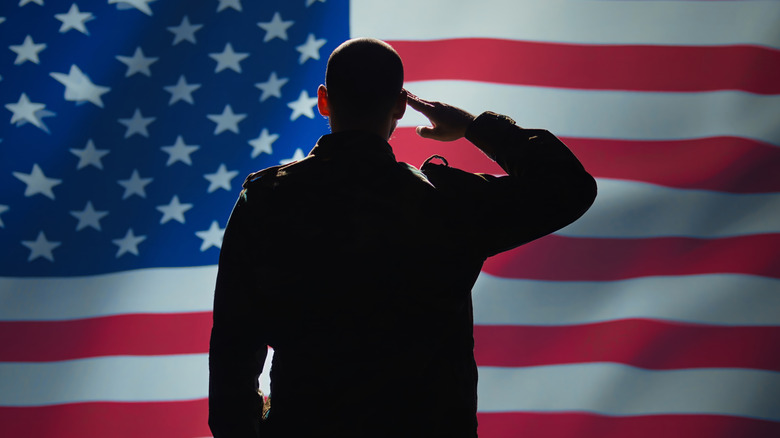The Real Reason American Flags Are Backwards On Military Uniforms
If we can say one thing for sure, it's that humans love their flags. Using flags as a symbol of a people, person, or region goes back to ancient Egyptian rulers raising personal battle standards full of shapes, emblems, and pictures of gods. Ancient Rome did the same, and also medieval Europe, which is when coats of arms took off. This segued to the earliest modern flag in 1625, the Danish Dannebrog. Now, every country on Earth has its own flag, many of which are typical rectangles while others, like Mozambique's, are unusually designed. All those flags, including that of the United States, must be displayed a particular way, raised to a certain height, folded in a certain way, etc. Except when the United States flag is on a military uniform, that is. Then it can be backwards.
It seems strange, doesn't it? Per Cornell Law School, U.S. Law Code, Title 4, Chapter 1, Paragraph 8 lists all the things you can't do to a flag. You can't flip it upside down, you can't let it touch the ground, it can't be laid flat, you can't fasten it to anything in a way that damages it, and more. The American Legion even mentions how it's supposed to be hoisted ("briskly") and lowered ("ceremoniously"), and names all the places where it has to be displayed, like near schools. So why, oh why, does it appear backward on military uniforms, of all places? The reason is kind of nifty: It's supposed to look like an actual flag caught in the wind as a soldier rushes forward.
Different flag rules for different uniforms
It kind of makes sense if you go through some visualization: There's a flag at the top of a handheld flag pole, someone is holding the flag high and running forward, and the flag catches in the wind and trails behind the person. Boom: instant reverse flag (unless you were originally viewing the flag from the reverse side). This image is especially pertinent for military personnel charging into battle.
Beyond this general idea, reverse flag regulations on military uniforms get surprisingly complex. First of all, when we say "flag," we're talking about a little patch that gets sewn onto the uniform. Since 2005, forward-facing flags have become mandatory somewhere on all military uniforms (except for the Marines and Coast Guard, which disallow it), but not the reverse flag. On the camouflage-patterned Army Combat Uniform (ACU) (including the National Guard), the reverse flag gets sewn into the right upper arm near the shoulder, while a regular flag gets sewn into the left upper arm. The 76-page Army Regulation 670–1 states that full-color flags must be worn on "utility and organizational" uniforms (there are lots of uniforms), but a subdued or muted flag can be worn when on a mission. Otherwise, bright flags would defeat the purpose of camouflage.
That's just the Army, too. Each branch of the military has its own forward and reverse flag rules. The Air Force, for instance, doesn't use subdued colors for either its forward or reverse flag. The Navy does, but only for the reverse flag.
How to wear a reverse flag patch
We mentioned Army Regulation 670-1, the big, extremely detailed document that details all the rules related to Army personnel appearances. Tattoos, for example, are prohibited, "below the wrist bone, and hands, except Soldiers may have one ring tattoo on each hand, below the joint of the bottom segment (portion closest to the palm) of the finger." Makeup is not okay if it contains, "eccentric, exaggerated, or faddish cosmetic styles and colors." There are similarly granular rules about hairstyles, jewelry, eyeglasses, fingernail grooming, as well as every single item of clothing possible, like fleece caps, scarves, umbrellas, undergarments, capes, cummerbunds, windbreakers, buttons, and loads more.
Given such specificities, you'd think that the rules for wearing forward or reverse flags are just as particular — but no. Army Regulation 670-1 just says that "soldiers will wear" reverse flags, and that's that. The Juniata County Veterans Council merely says that it's "appropriate" that flags be on upper arms. The left arm displays the forward flag, and on the right arm, "it is considered proper" to display the reverse flag. But, nowhere does the Army explicitly say where a flag patch needs to be displayed, or how. This odd lack of specificity might be due to differences in state and city laws regarding displaying flags, which would make sense. Plus at this point, we've got a tradition of wearing flags on upper arms, complete with uniforms designed and issued for this purpose.
The history of wearing a reverse flag
So where did all this reverse flag stuff come from? If tales are to be believed, it wasn't until paratroopers came along that wearing a reverse flag patch became standard practice. Paratrooping didn't exist until Italy's first paratroop drop in 1927. Bit by bit, other countries started experimenting with paratroopers, like Russia, Germany, the U.K., and the U.S. This happened during World War II, with the United States deploying its first paratroopers in 1942. Paratroopers were the first to wear reverse flags out of a need to identify each other behind enemy lines.
At the same time, sites like Medal of America say that the idea for a reverse flag patch — which resembles a flag flying behind a soldier — dates to the U.S. Civil War (1861 to 1865). Flag bearers rushed forward, "flying a flag as a symbol of honor and respect for the country for which they were fighting." The Stratford Veterans Museum says that the whole flag-flying thing goes back earlier to cavalry flag-bearers. But realistically, if humans really have been using flags as far back as ancient Egypt, we're pretty sure someone else noticed that they looked backward when running forward well before the U.S. Civil War.
Regardless of the origin, reverse flags became common in the U.S. only starting around 2003 amidst post-9/11 fervor, before flags in general became mandatory in 2005. Reverse flags became associated with the phrase "assaulting forward," as though each soldier wearing a reverse flag was carrying a real flag that flew backwards.



